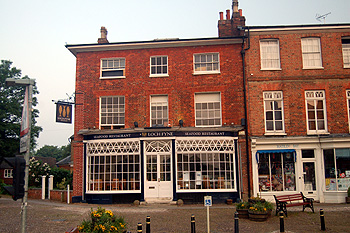The Plough and Wheatsheaf Public House Woburn

17 and 18 Market Place May 2012
The Plough and Wheatsheaf Public House: Back Lane, Woburn
There is only one reference to this public house and this is in a deed of 1724 when Sir Gilbert Pickering and Dame, Elizabeth, his wife, conveyed a piece of ground in Woburn to John Taylor, wheelwright for £20 [R6/63/7/2]. the piece of land is described as five poles standing between ground of William Turner to the north-east and Jeremiah Rowbard to the south-west "whereupon a messuage or tenement lately stood that was burnt doen in the dreadful fire and was then or late called the Plow and Wheatsheafe".
One can carry out considerable conjecture. We know that a licensed establishment called The Plough (later called The Queen's Head) was damaged in the same fire. We also know that Jeremiah Rowbard or Rowberd also owned an inn called The White Lion. This lay in the Market Place and was described as a former inn by 1724. By 1777 the premises had once more become licensed as The Wheatsheaf. Whether it is a coincidence that the Wheatsheaf stood near the site of a public house previously called the Plough and Wheatsheaf or not is unknown. It is also not known where The Plough had stood and whether that was nearby or not.
Based on the evidence of the site of the Plough and Wheatsheaf adjoining the White Lion, which seems to have stood on or near the site of today's 20 Market Place (a 19th century building) we can conjecture that the Plough and Wheatsheaf stood either on or near the site of today's 18 Market Place, which date to the later 18th century. 19 Market Place dates to about 1725 but encases an older building which seems to rule out its being the Plough and Wheatsheaf which was described as "burnt down" unless this was an exaggeration and the building was simply badly damaged.
The piece of land bought by Taylor in 1724 was devised in his will of 1755 to his son, also John Taylor [R6/63/7/6]. It was then a cottage with a yard, barn and stable. In 1787 Stephen Taylor, probably John junior's son, married Mary Gale and the property formed part of the marriage settlement [R6/63/7/12]. It was the described as near the market place and bounded one side by a property of Robert Carey and the other by a property of John Thornton. Stephen Taylor in his will of 1794 [R6/63/7/21] devised his real estate to Solomon, son of William and Mary Fountain of Buckland [Buckinghamshire], horse dealer. In 1801 Fountain conveyed the property to the Duke of Bedford [R6/63/7/27].

19 Market Place May 2012
Sources:
-
R6/63/7/2: conveyance: 1724;
-
R6/63/7/6: will: 1755;
-
R6/63/7/12: marriage settlement: 1787;
-
R6/63/7/21: will: 1794;
-
R6/63/7/27: conveyance: 1801.